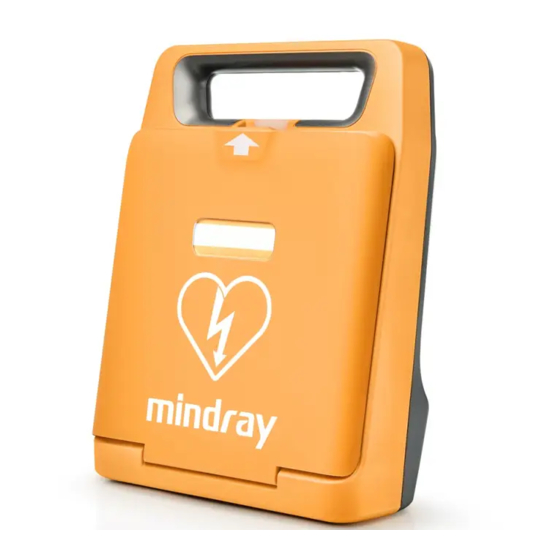
Table of Contents
Advertisement
Quick Links
BeneHeart C & BeneHeart S Series
Automatic External Defibrillator
Operator's Manual
(BeneHeart C1/BeneHeart C1A/BeneHeart C2/BeneHeart C2A/
BeneHeart C1 Fully Automatic/BeneHeart C1A Fully Automatic/
BeneHeart C2 Fully Automatic/BeneHeart C2A Fully Automatic/
BeneHeart S1/BeneHeart S1A/BeneHeart S2/BeneHeartS2A/
BeneHeart S1 Fully Automatic/BeneHeart S1A Fully Automatic/
BeneHeart S2 Fully Automatic/BeneHeart S2A Fully Automatic)
Advertisement
Table of Contents

Summarization of Contents
1 Safety Information
1.1.1 Dangers
Highlights imminent hazards that could result in death or serious injury.
1.1.2 Warnings
Alerts to potential hazards or unsafe practices that could lead to death or serious injury.
1.1.3 Cautions
Indicates potential hazards or unsafe practices that could result in minor personal injury or damage.
1.1.4 Notes
Provides application tips and other useful information for optimal product use.
1.2 Equipment Symbols
Explains the meaning of various symbols used on the equipment and in the manual.
2 Equipment Introduction
2.1 Overview of BeneHeart C & S Series
Provides a general description of the BeneHeart C & S series AEDs and their product models.
2.2 Intended Use and Patient Population
Defines the intended application of the BeneHeart C & S series defibrillator for adults and children.
2.3 Applied Parts Identification
Lists and describes the components attached to the patient during operation, like electrode pads.
2.4 Main Unit Component Views
Details the primary components and visual views (Top, Bottom, Back) of the AED unit.
3 Getting Started
3.1 Preparation Safety Information
Provides critical safety precautions and warnings before installing and operating the equipment.
3.2 Equipment Unpacking and Checking
Guides through the process of unpacking, checking, and inspecting the equipment and accessories.
3.2.1 Environmental Requirements
Details the necessary environmental conditions for operating the equipment.
3.2.2 Connecting Electrode Pads
Provides instructions for connecting the electrode pads to the AED unit.
3.3 Turning Equipment On/Off
Details the procedures for turning the equipment on and off, including inspections.
3.4 Switching Voice Language
Explains how to change the voice prompts language on the defibrillator.
4 Using the Equipment
4.1 Operating Safety Information
Provides essential safety guidelines and warnings for operating the defibrillator during use.
4.2 Screen Display Overview
Explains the various elements displayed on the AED's screen interface.
4.3 Responding to a Rescue
Guides through the step-by-step process of responding to a cardiac emergency rescue.
4.4 Performing CPR
Details how to perform Cardiopulmonary Resuscitation using the AED's guidance.
4.4.1 Using the CPR Metronome
Explains how to use the CPR metronome feature for guided compressions and ventilation.
4.4.2 Using the CPR Sensor
Details connecting and using the CPR sensor for real-time compression feedback.
4.5 Preparing for Next Rescue
Details steps for preparing the equipment after a rescue for subsequent use.
5 Data Management
5.1 Data Management Overview
Lists data stored in the equipment and methods for managing it.
5.2 Generating Patient Files
Explains how patient files are automatically created and managed.
5.3 Managing Configurations
Describes how to view, change, and restore equipment configurations.
5.4 AED ALERT System Overview
Introduces the AED ALERT system for remote monitoring and management of equipment.
5.5 Accessing the AED ALERT System
Provides instructions on how to access the AED ALERT system via the internet.
6 Battery
6.1 Battery Introduction and Safety
Covers battery introduction, safety information, and indications of battery status.
6.2 Battery Replacement
Provides a step-by-step guide for safely replacing the battery in the equipment.
6.3 Battery Storage and Recycling
Details proper methods for storing batteries and guidelines for their disposal.
7 Care and Cleaning
7.1 General Care and Cleaning Procedures
Provides general guidelines and precautions for cleaning and maintaining the equipment.
7.2 Disinfection and Sterilization
Outlines procedures for disinfecting and states sterilization is not recommended.
8 Maintenance and Testing
8.1 Maintenance Introduction and Safety
Covers maintenance introduction and essential safety information for performing tasks.
8.3 Performing User Test
Details the procedure for performing a user test on the equipment.
8.3.1 Auto Test Function
Explains the automatic test function, its timing, and result indicators.
8.3.2 Electrode Pads Check
Describes the monthly check for electrode pad expiration dates.
8.4 Disposing the Equipment
Provides guidance on the proper disposal of the equipment and its accessories.
9 Accessories
9.1 Therapy Accessories
Lists and describes accessories used for therapy, such as electrode pads and CPR sensor.
9.2 Miscellaneous Accessories
Lists miscellaneous accessories, such as disposable batteries.
A Specifications
A.1 Safety, Environmental, and Interface Specifications
Details safety, environmental, interface, and connectivity specifications for the equipment.
A.2 Battery, Data Storage, Wireless, and Defibrillator Specs
Covers battery, data storage, wireless, defibrillator, ECG, and electrode pad specifications.
B Mindray Shockable Rhythm Analysis Algorithm
B.1 Rhythm Recognition Methodology
Explains the methodology, databases, and categories for rhythm recognition analysis.
B.2 Algorithm Performance Metrics
Presents test results for the algorithm's performance against standards and recommendations.
C EMC and Radio Regulatory Compliance
C.1 Electromagnetic Compatibility (EMC)
Details Electromagnetic Compatibility requirements, emissions, and immunity guidance.
C.2 Radio Regulatory Compliance
Outlines radio regulatory compliance for Wi-Fi and cellular modules.
D Default Settings
D.1 General Setup
Lists default settings for system date, time, language, volume, brightness, and patient type.
D.2 AED, CPR, Test, Network, and ALERT Defaults
Details default settings for AED, CPR, testing, network, and AED ALERT configurations.
E Voice Prompts
E.1 Voice Prompts During Rescue
Lists voice prompts and their descriptions for various conditions during a rescue operation.
F Symbols and Abbreviations
F.1 Units and Symbols
Lists common units of measurement and various symbols used in the manual.
F.2 Abbreviations and Acronyms
Provides a list of abbreviations and acronyms used in the manual with their full forms.
G Inspection Record
G.1 Daily and Monthly Inspection Checklist
Provides a template for recording daily and monthly equipment inspections and pad expiration.
H Device Tracking
H.1 Product Tracking Information
Explains the process for tracking the defibrillator product and providing service information.
Declaration of Conformity
Declaration of Conformity V1.0
Formal declaration that the product meets EU radio equipment directives and applied standards.













Need help?
Do you have a question about the BeneHeart C1A and is the answer not in the manual?
Questions and answers